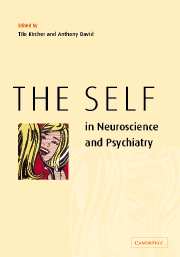Book contents
- Frontmatter
- Contents
- List of contributors
- Introduction: the self and neuroscience
- Part I Conceptual background
- Part II Cognitive and neurosciences
- 5 The multiplicity of consciousness and the emergence of the self
- 6 Asynchrony, implicational meaning and the experience of self in schizophrenia
- 7 Self-awareness, social intelligence and schizophrenia
- 8 The neural correlates of self-awareness and self-recognition
- 9 Autonoetic consciousness
- 10 The neural nature of the core SELF: implications for understanding schizophrenia
- Part III Disturbances of the self: the case of schizophrenia
- References
6 - Asynchrony, implicational meaning and the experience of self in schizophrenia
from Part II - Cognitive and neurosciences
Published online by Cambridge University Press: 18 December 2009
- Frontmatter
- Contents
- List of contributors
- Introduction: the self and neuroscience
- Part I Conceptual background
- Part II Cognitive and neurosciences
- 5 The multiplicity of consciousness and the emergence of the self
- 6 Asynchrony, implicational meaning and the experience of self in schizophrenia
- 7 Self-awareness, social intelligence and schizophrenia
- 8 The neural correlates of self-awareness and self-recognition
- 9 Autonoetic consciousness
- 10 The neural nature of the core SELF: implications for understanding schizophrenia
- Part III Disturbances of the self: the case of schizophrenia
- References
Summary
Abstract
This chapter opens by outlining the basic architecture of interacting cognitive subsystems (Barnard, 1985, 1999) and then briefly summarizes its application to depression (Barnard & Teasdale, 1991; Teasdale & Barnard, 1993). The account of depression relies on the idea that cognitive-affective processes involve two distinct kinds of meaning: propositional meaning and implicational meaning. Propositional meaning is referentially specific while implicational meaning is more abstract and generic in nature. Affect and ideation are linked up in schematic models encoded as implicational meanings. Among other things, these schematic models represent our sense of self. In a context where negative self-schematic models dominate mental processing, feedback from propositional and body state representations acts to regenerate negative self-models and, in doing so, sustains depression.
The chapter then considers how the mechanisms underlying processing exchanges between two types of meaning can be extended to develop accounts of the core symptoms of a broader range of psychopathologies and the individual variation so often seen in symptom expression. The extension postulates four underlying sources of variation that constrain the dynamic processing of meaning. They are: (1) variation in the content of semantic representations; (2) variation in the rate of change in the content of mental images; (3) variation in the mode in which mental processes operate; and (4) variation in the synchronization of the processes that generate meaning. All four sources of variation are needed to account for variation in symptom expression across and within types of psychopathology.
- Type
- Chapter
- Information
- The Self in Neuroscience and Psychiatry , pp. 121 - 146Publisher: Cambridge University PressPrint publication year: 2003
References
- 12
- Cited by

